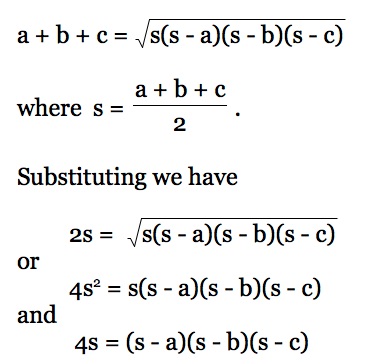

Jim Wilson
Perfect Triangles are triangles with integer sides, integer area, and numerically equal area and perimeter. Find all such triangles. The problem can be approached using Heron's formula.
Analysis
Our triangle with sides of lengths a, b , and c has area and perimeter numerically equal. That is

Searching for integer values of a, b, and c can be simpler by substituting
Note:
s = x + y + z
a = z + y
b = x + z
c = x + y
Then,
and the relation with numerically equal perimeter and area becomes
4(x + y + z) = xyzThere is no loss of generality to assume that x < y < z. Note that this means x and y will be the lengths adjacent to the largest angle -- opposite the longest side.
Can you find integer x, y, and z to satisfy the equation 4(x + y + z) = xyz ?
Now, x corresponds to the longest side of the triangle and intuitively we can see that it must be fairly close to s. That is, x is relatively small. In fact, x, the smallest of x, y, or z, can only be 1, 2, or 3. Now consider each case.
When x = 1,
4(1 + y + z) = yz
yz - 4y - 4z = 4
y(z -4) - 4z = 4
y(z - 4) - 4(z - 4) - 16 = 4
(y - 4)(z - 4) = 20and thus integer values of (x, y, z) are (1, 5, 24), (1, 6, 14) or (1, 8, 9). These are the only possible triples because the product pairs for 20 are (1, 20), (2, 10), (4, 5).
When x = 2, a similar process leads to (x, y, z) as (2, 3, 10) or (2, 4, 6).
4(2 + y + z) = 2yz
2yz - 4y - 4z = 8
yz - 2y - 2z = 4
y(z -2) - 2z = 4
y(z -2) - 2(z -2) - 4 = 4
(y -2) (z -2)= 8Again, these are the only triples because the only product pairs for 8 are (1, 8), and (2, 4).
When x = 3,
4(3+ y + z) = 3yz
3yz - 4y - 4z = 12
9yz - 12y - 12z = 36
3y(3z -4) - 12z = 36
3y(3z -4) - 4(3z -4) - 16 = 36
(3y -4) (3z-4)= 52The product pairs for 52 are ( 1, 52), (2, 26), and (4, 13). The first and third do not lead to integer values for y and z. The second does not preserve the order for x and y (or it duplicates a previous case).
Therefore there are exactly 5 triangles with integer sides and integer area having numerically equal perimeter and area. They are:
(x, y, z)------ (a, b, c)
(1, 5, 24)------(29, 25, 6)
(1, 6, 14)----- (20, 15, 7)
(1, 8, 9)------(17, 10, 9)
(2, 3, 10)------(13, 12, 5)
(2, 4, 6)-------(10, 8, 6)Of these triangles, the last two are right triangles. Why? The square of the first side length is the sum of the squares of the other two side lengths. The other three are obtuse because the sum of the square of the longest side is greater that the sum of the squares of the lengths of the other two sides.
Reference:
Starke, E. P. (1969) An old triangle problem. Mathematics Magazine, Jan-Feb, p.47.